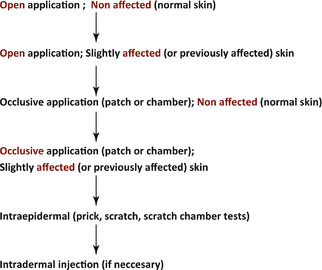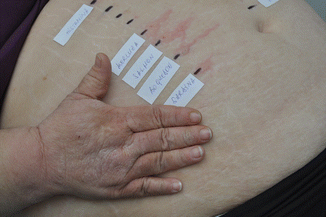Stage 1
Localized urticaria (redness and swelling)
Immediate contact dermatitis (eczema – protein contact dermatitis)
Itching, tingling, or burning sensation
Stage 2
Generalized urticaria
Stage 3
Bronchial asthma (wheezing)
Rhinitis, conjunctivitis (runny nose, watery eyes)
Orolaryngeal symptoms (lip swelling, hoarseness, difficulty swallowing)
Gastrointestinal symptoms (nausea, vomiting, diarrhea, cramps)
Stage 4
Anaphylactic or anaphylactoid reaction (shock)
8.4 What Do We Know About the Mechanisms Involved in PCD?
The mechanisms underlying immediate contact skin reactions are partially understood. Each trigger substance has its own mechanism or mechanisms of action. Non-immunologic CoU (NICoU) is due to vasogenic mediators without involvement of immunological processes. The pathogenesis of immunological CoU (ICoU) reflects a type I hypersensitivity reaction, mediated by allergen-specific immunoglobin E (IgE) in a previously sensitized subjects [22]. Skin challenge involves allergen penetration through the epidermis, IgE binding on mast cells, its degranulation, and subsequent release of histamine and other vasoactive substances as prostaglandins, leukotrienes, and kinins.
A combination of type I and type IV allergic skin reactions, the latter supported by positive delayed patch tests, has been suggested as PCD pathogenesis [23, 24]. It has been speculated that PCD is an eczematous IgE-mediated reaction through proteins. PCD shows a similar reaction pattern to aeroallergen-induced atopic eczema or dermatitis [25].
8.5 How to Confirm the Responsible Environmental Agent of PCD
Diagnosis of PCD as of any of the diseases included in the CUS is based on full medical history and skin testing with suspected substances (Fig. 8.1).


Fig. 8.1
Diagnostic flowchart to test CoU and PCD from the CUS. Proceed to the following suggested provocation test if the test done is negative
In vitro techniques are available for only a few allergens, including latex. The simplest cutaneous provocation test for ICoU, NICoU, and immediate contact dermatitis as PCD is the “open test.” The suspected substance studied is applied and gently rubbed on slightly affected skin or on a normal-looking 3 × 3 cm area of the skin, either on the upper back or the extensor side of the upper arm. Often it is desirable to apply contact urticants to skin sites suggested by the patient’s history. The suspected substance, commonly foods, is brought by the patient. A positive result is an edema and/or erythema typical of CoU or tiny intraepidermal spongiotic vesicles typical of acute eczema. An immunological and non-immunological contact reaction usually appears within 15–20 min being the non-immunological one lasting within 45–60 min. ICoU can also show a delayed onset, although this is rare.
When the open test results are negative, “prick testing” of suspected allergens using often “prick by prick is the method of choice for immediate contact reactions (Fig. 8.2).


Fig. 8.2
Eczema at the dorsum of hand induced by proteins habitually touched in the daily work of a fisher woman sailor. Positive wheal induced by prick by prick test with hake, salmon, anchovy, and sardine
“Scratch test” and “chamber scratch test” (contact with a small aluminum chamber for 15 min) are less standardized than the prick test but are useful when a nonstandard allergen must be studied. For both prick and scratch tests, histamine hydrochloride serves as the positive control and aqueous sodium hydroxide as negative reference. When other than cutaneous organs are involved, it is important to begin ICoU testing with much diluted allergen concentrations and to use serial dilutions to minimize allergen exposure. When testing with poorly or nonstandardized substances, control tests should be assessed on at least 20 people to avoid false-positive interpretation. Nonsteroidal anti-inflammatory drugs and antihistamines should be avoided because of the risk of false-negative results. Following the recommended protocol is important for minimizing the occurrence of hazardous extracutaneous reactions. Life-threatening reactions have been documented during skin tests; therefore, caution is advised, especially when testing certain occupational substances. Skin tests should be performed only if resuscitation equipment and trained personnel are readily available [26–28].
8.6 Responsible Agents of PCD as Part of the CUS
Proteins (molecular weight 10,000 to several hundred thousands) and also chemicals (molecular weights below 1000) can trigger CUS [29]. Proteins from plants, food, or animals are the main responsible agents of PCD. We know that commonly the same type of protein can be responsible of dermatitis, wheals, or pruritus. Plant or animal proteins, but also chemicals such as drugs and preservatives, or more diverse substances such as metals and industrial chemicals, can induce immunological CoU. Natural rubber latex allergy focused global interest at the end of the twentieth century. Latex sensitization risk factors include atopy and prolonged exposure via damaged epidermis, e.g., glove wearers with hand eczema.
A huge amount of compounds can be responsible of occupational and non-occupational CUS including animal products, plants and plant derivatives, foods, fragrances, cosmetics, flavorings, medications, preservatives, disinfectants, enzymes, metals, and miscellanea of different substances.
8.7 Treatment and Prevention of PCD
CUS clinical symptoms are determined by the route, duration, and extent of exposure, the inherent sensitizing properties of the allergen, and an individual’s genetic and/or acquired susceptibility. The best way to treat PCD is based in a correct etiological diagnosis. Identifying the responsible agent is required to avoid correctly the cause. Avoidance of further exposure will improve occupational PCD and CoU. Primary and secondary prevention measures are highly recommended being necessary common guidelines in order to prevent well-known occupational risks as, e.g., latex allergy [30].
Hand and wrist dermatitis is the common location of PCD. For hand dermatitis along with emollients, the local treatment of choice is a topical corticosteroid. These agents are very effective in the short term. The disadvantages of topical corticosteroids include cutaneous adverse effects (skin atrophy), tachyphylaxis, and adrenal suppression after systemic absorption; however, this is rare. Anecdotal experience suggests that intermittent dosing may reduce the risk of adverse effects. Clinical experience suggests that alternating a topical corticosteroid with a topical calcineurin inhibitor may reduce adverse effects, though randomized clinical trials are missing and the long-term safety of this approach is unknown.
Stay updated, free articles. Join our Telegram channel

Full access? Get Clinical Tree







